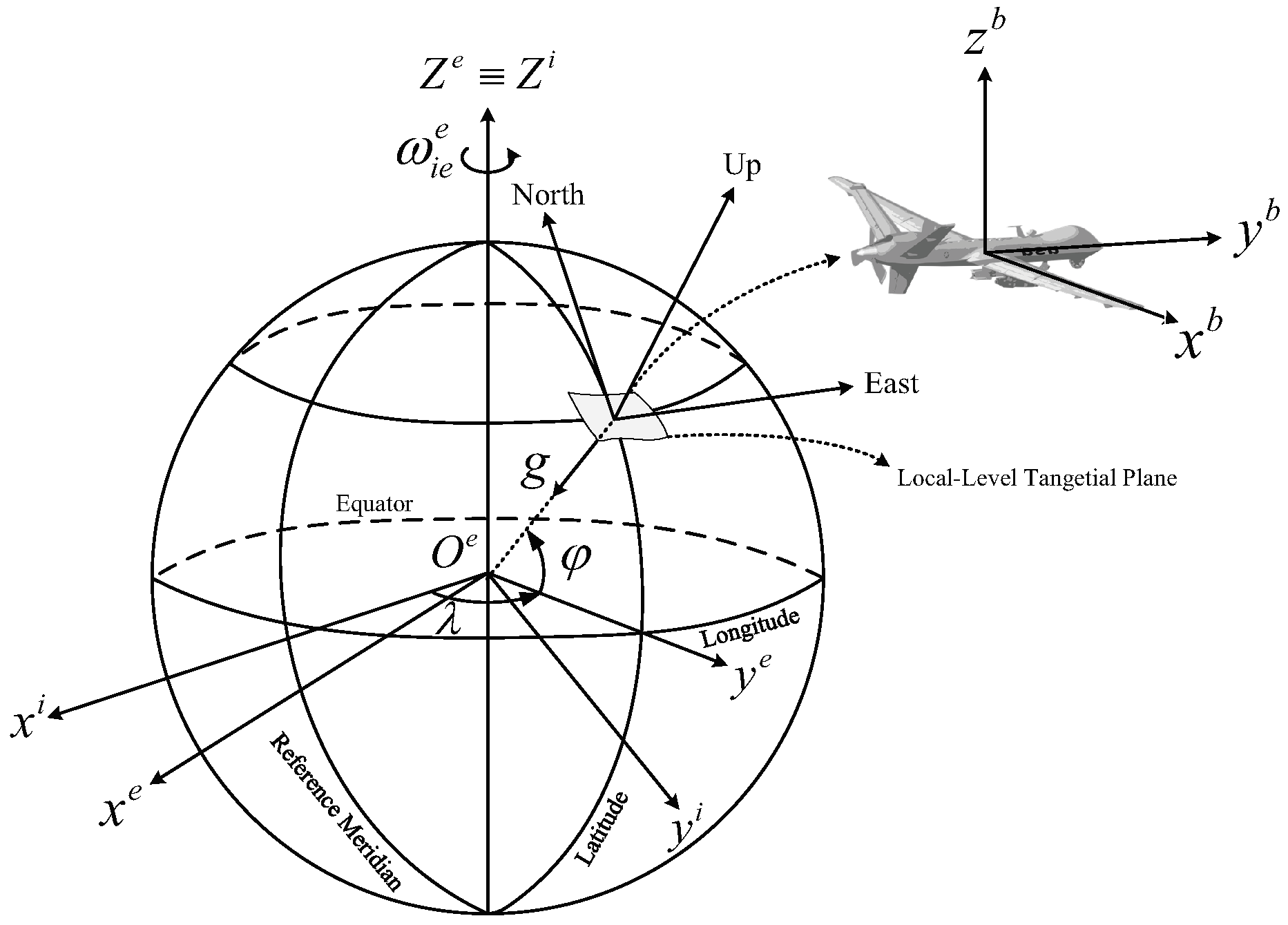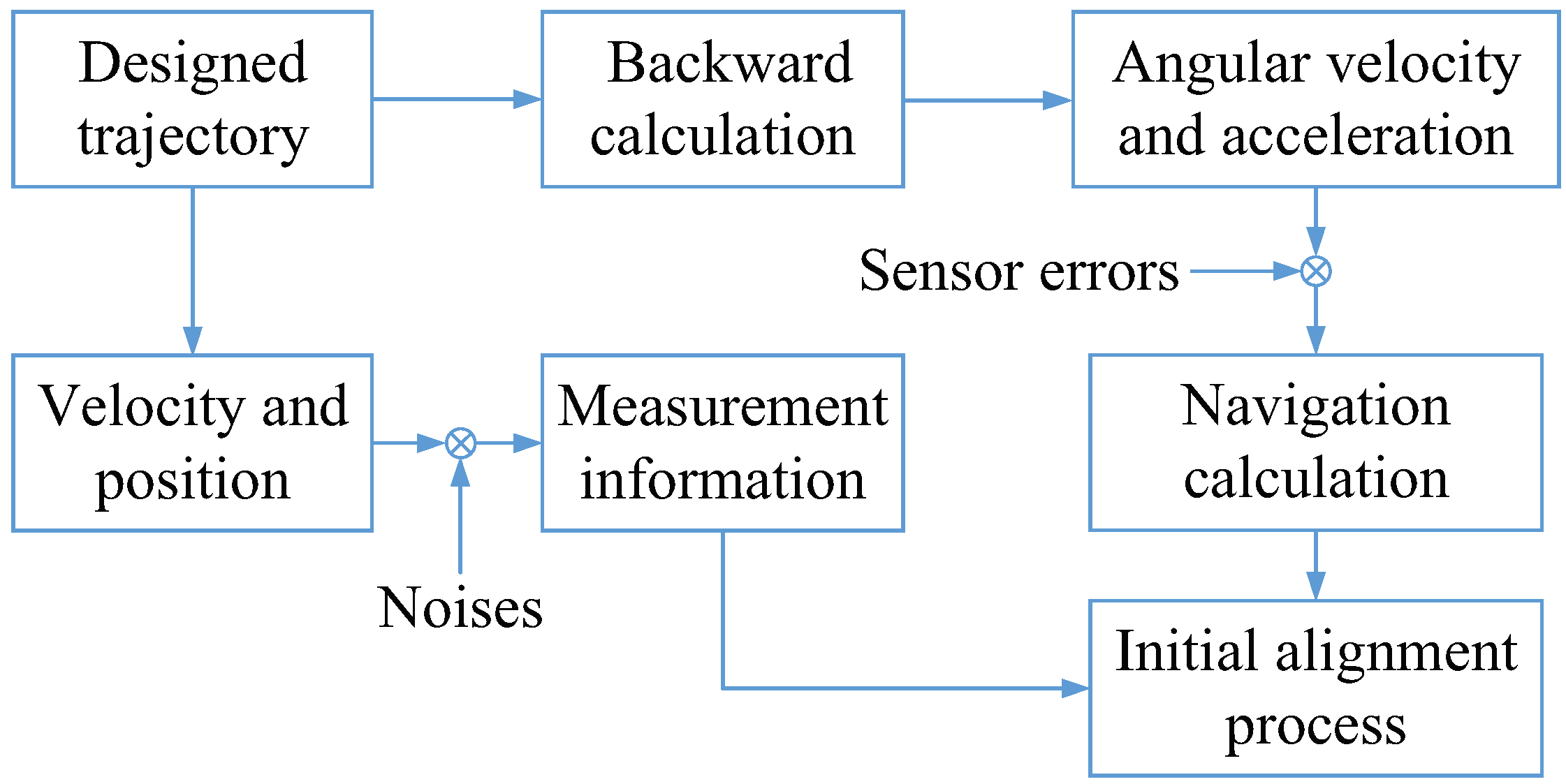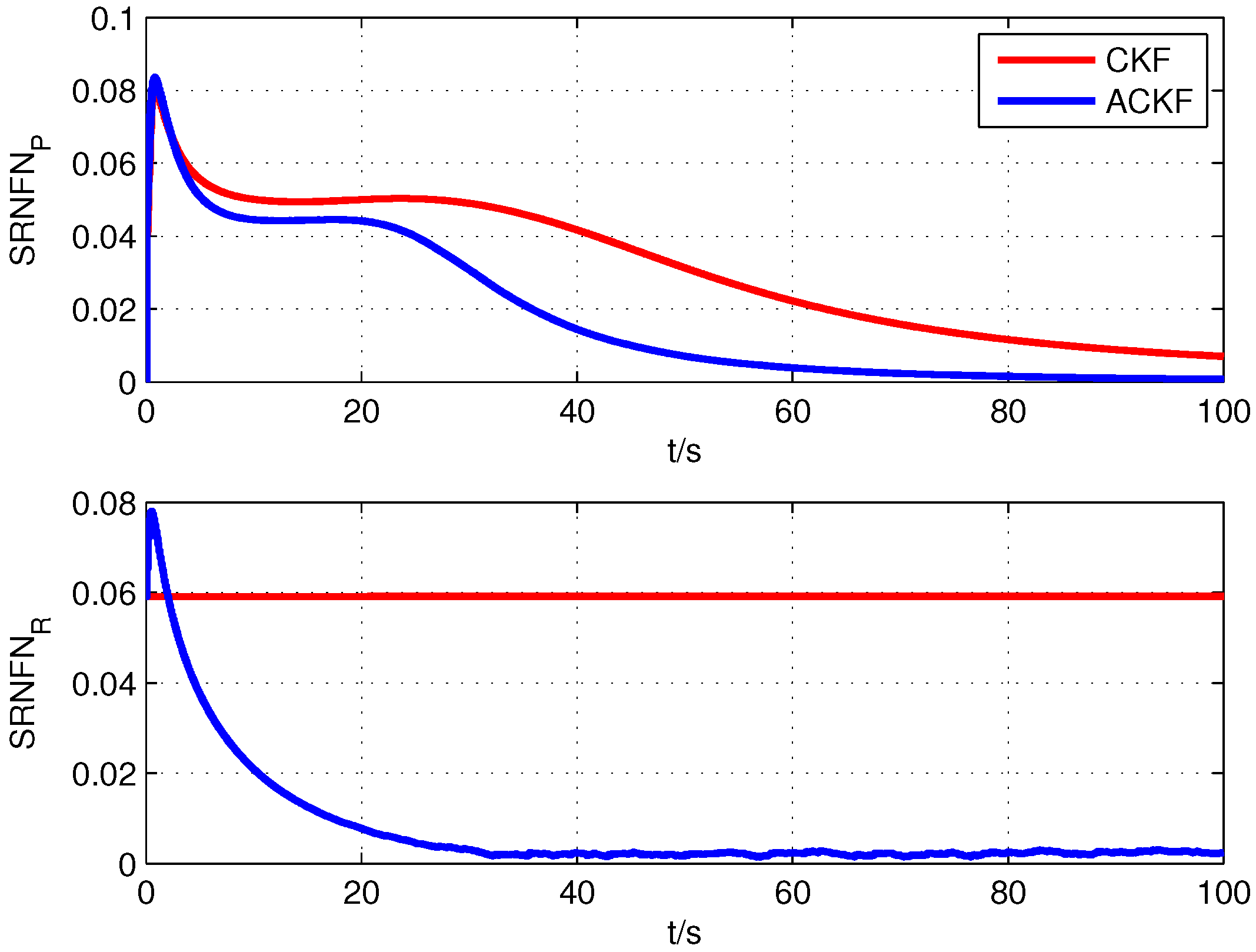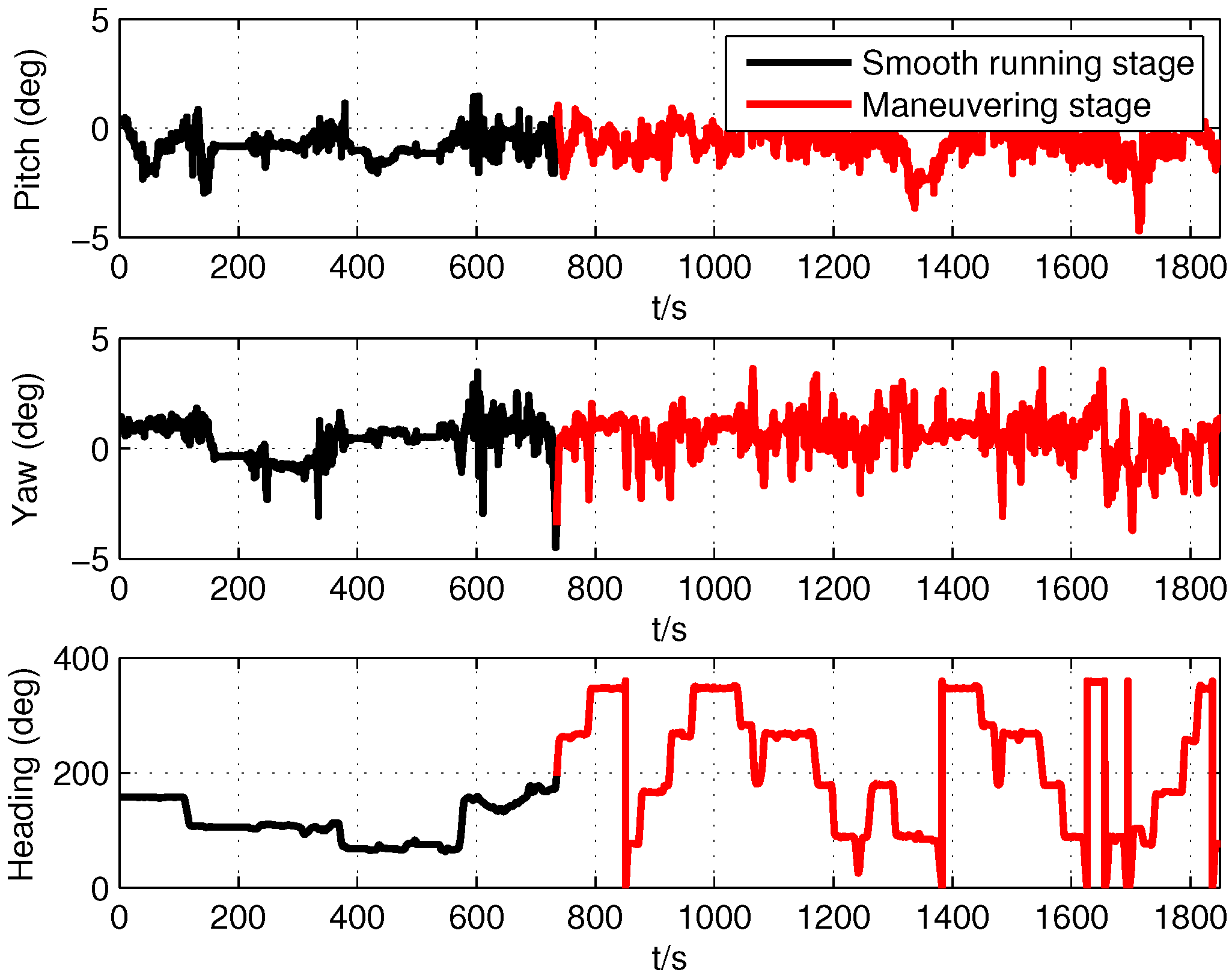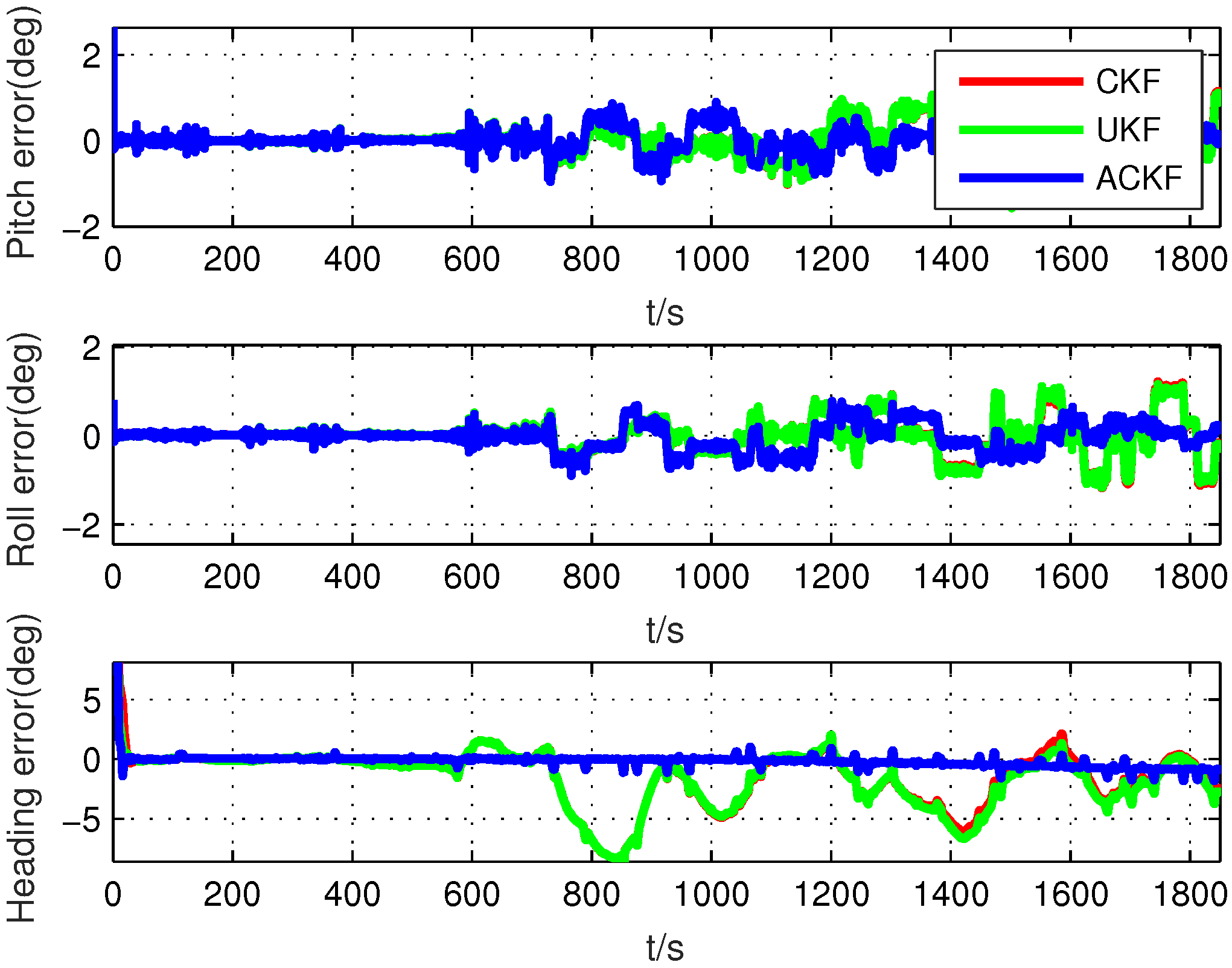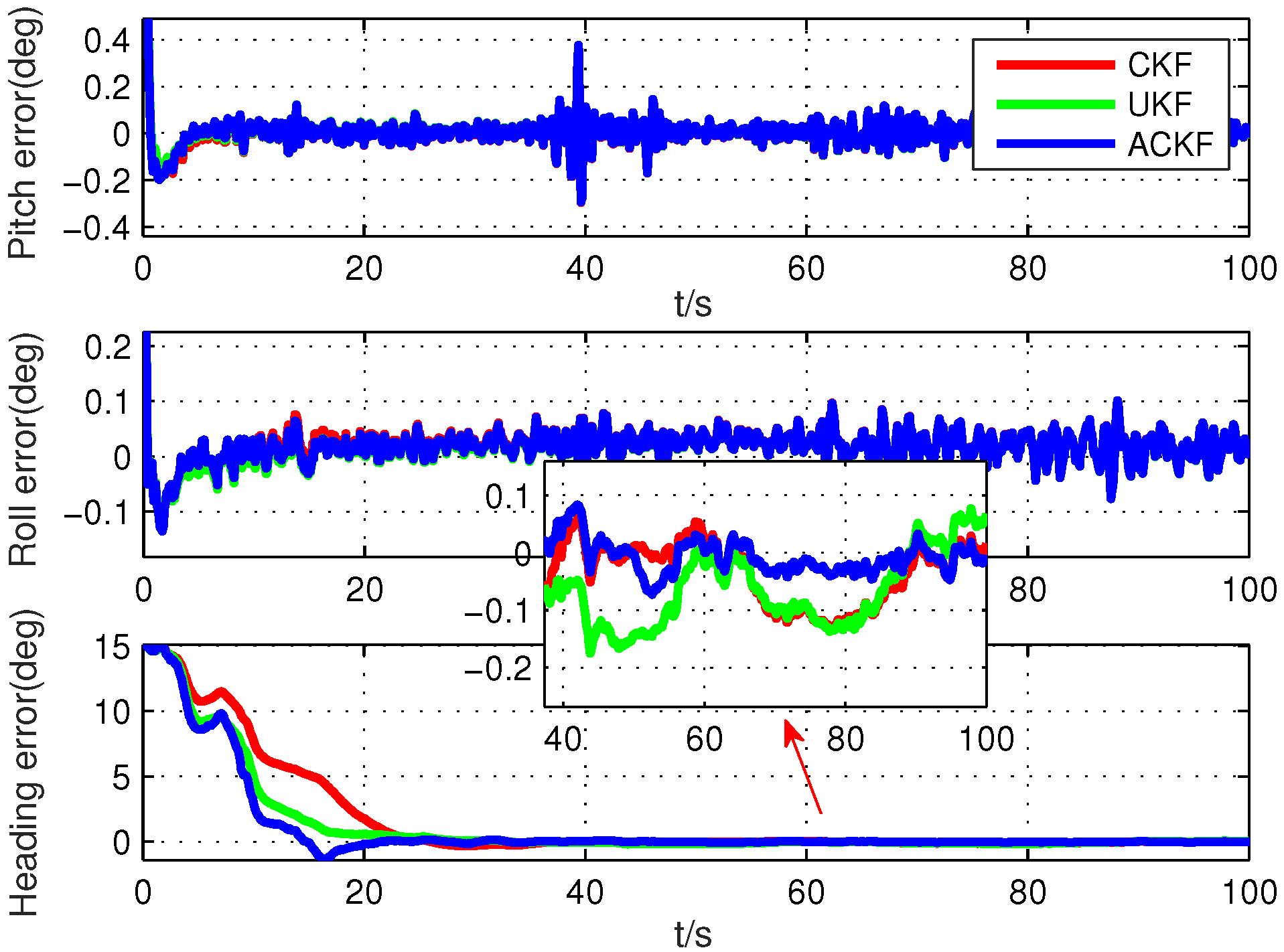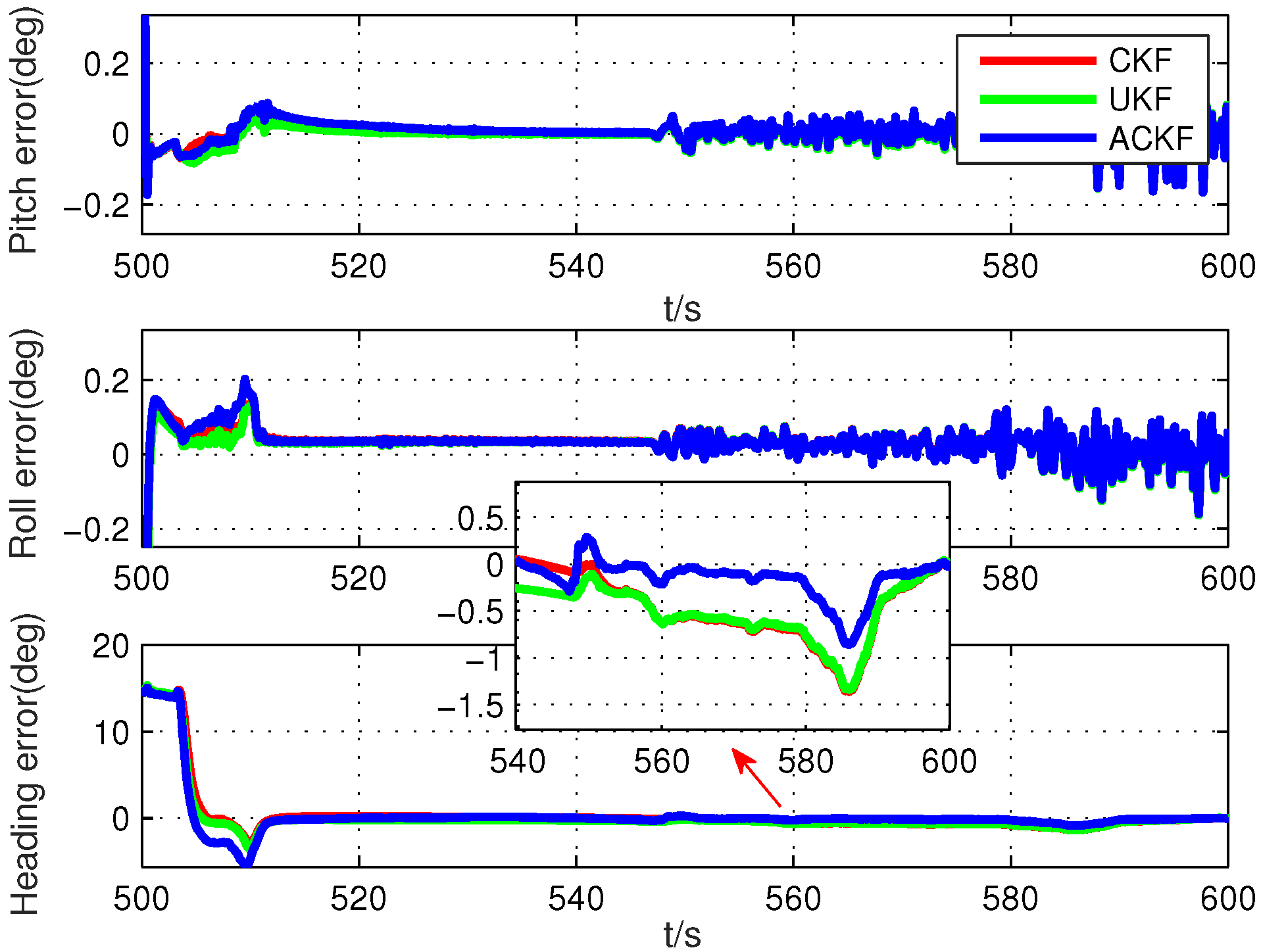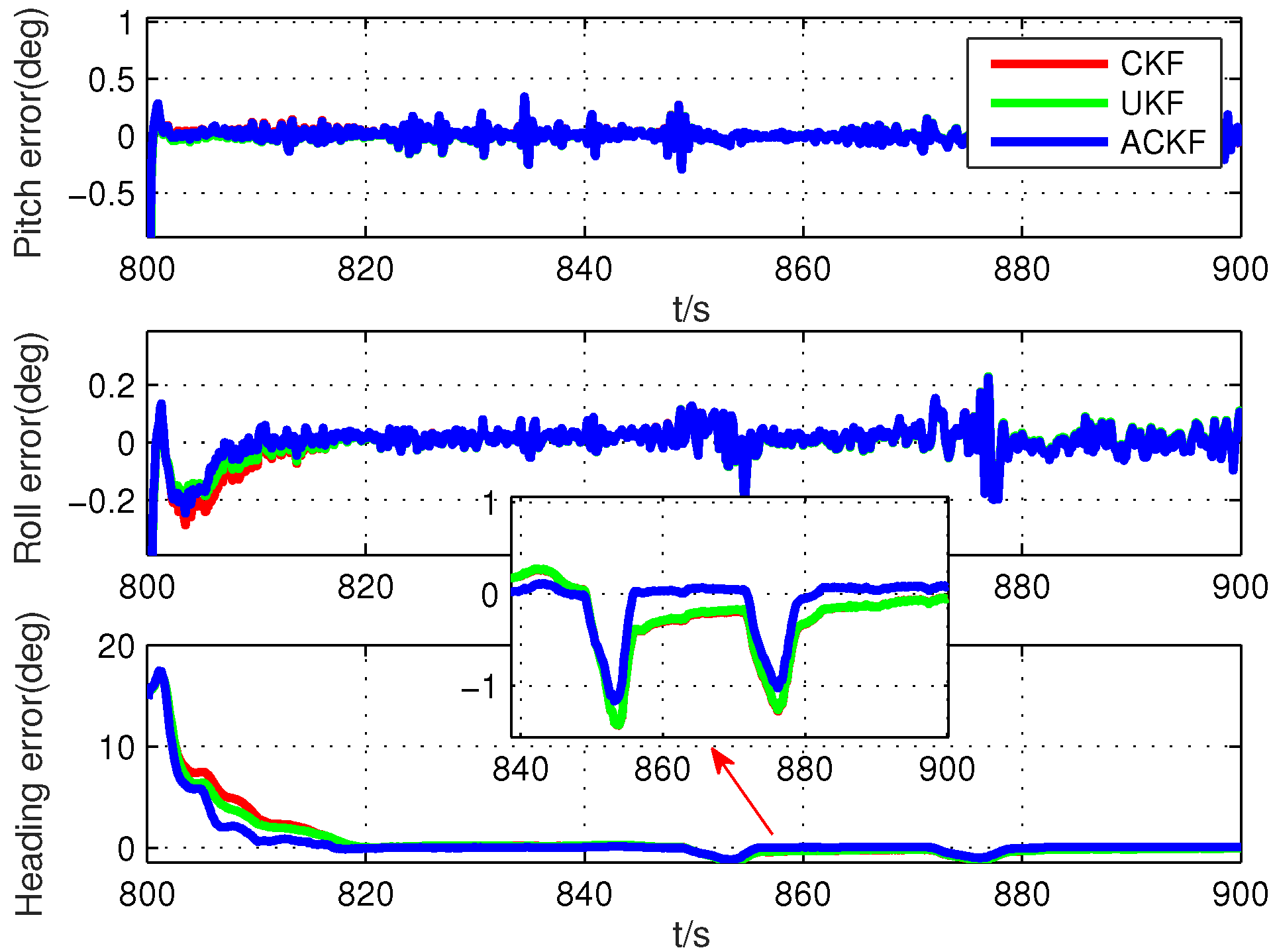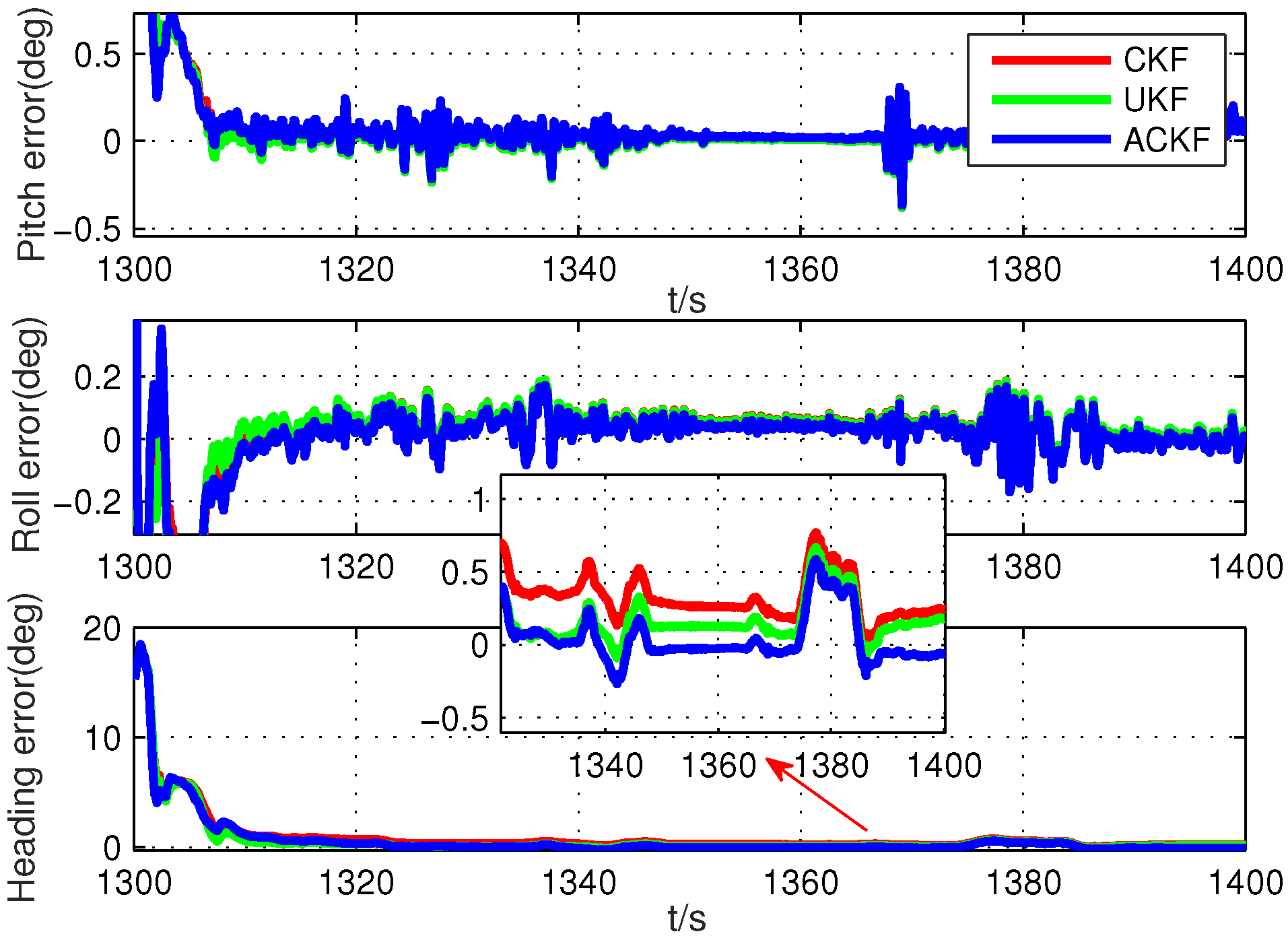In this section, a novel adaptive CKF is proposed to solve the estimation problem with the uncertain noise covariance matrix. Without loss of generality, we introduce this method based on the standard nonlinear model with the nonlinear state and measurement functions.
3.1. Gaussian Kalman Filter and Cubature Kalman Filter
The Gaussian filter is the main method to solve the nonlinear estimation, which has two key assumptions, that the one step predicted PDFs of the state and measurement are Gaussian, i.e.,
where
and
denote the mean and variance of
.
where
and
denote the mean and variance of
.
Obviously, the joint one step predicted PDF of the state and measurement
is also Gaussian, i.e.,
where
is the covariance of
and
. Based on (
14) and (
15), in the Bayesian theorem, the posterior PDF of
is also Gaussian, i.e.,
where
and
denote the mean and variance of
.
and
are derived as follows:
where
is the filter gain, and the other parameters are calculated as follows:
where
means the expectation operation.
From (
20) to (
24), the general framework of the Gaussian filter is established, and the core idea of the Gaussian filter is to calculate Gaussian weighted integrals. Due to the nonlinearity of
and
, it is difficult to obtain the accurate numerical solution of (
20)–(
24), and the approximation solution is necessary, i.e.,
where
and
are the sampling points and corresponding weights of
.
CKF, which is a typical Gaussian filter, uses the third degree spherical–radial cubature rule to obtain these weighted samples. In (
20), the cubature points of
are selected based on
and
. These cubature points are defined as follows:
where
denotes the
jth column of
A. Propagating the cubature points of
by
, the state one step predicted mean
and covariance
can be obtained as follows based on (
20) and (
21):
Furthermore, the cubature points of
based on
and
are selected as follows:
Propagating the cubature points of
by
, the measurement one step predicted mean and covariance can be obtained as follows:
Filter gain
and measurement update are given as follows:
3.2. The Proposed Adaptive Cubature Kalman Filter
When the state noise covariance and measurement noise covariance are unknown or inaccurate, the estimation accuracy of CKF may degrade or diverge. Because the one step predicted state error covariance is influenced by the inaccurate , it is easier to estimate than . Therefore, in our works, the state, one step predicted state error covariance and are jointly estimated to improve the accuracy of CKF with inaccurate noise statistical properties.
In the frame of Bayesian probability theory, the conjugate prior distribution is selected to guarantee the unified form of the prior and posterior distribution. For the Gaussian distribution with known mean, the standard inverse Wishart (IW) PDF is always used as the conjugate prior distribution. The IW PDF is formulated as follows:
where
is positive definite random matrix,
is the inverse scale matrix,
is the degrees of freedom (dof) parameter,
d is the dimension of
,
is the trace calculation, and
is the
d-variate Gamma function. When
, the mean of
is shown as follows:
Therefore, the prior distribution
and
are modeled as follows:
where
and
are dof parameters and
and
are inverse scale matrices.
The mean value of
is set as nominal
, determined by:
where
is the nominal state noise covariance matrix, which means an inaccurate value.
Let:
and set
, where
is a tuning parameter. We can obtain:
According to the Bayesian theorem,
is formulated as:
where
is the posterior PDF of
. Because the posterior and prior PDF of
has the same distribution, the posterior PDF of
is also formulated as the inverse Wishart distribution, as follows:
Because of the unknown dynamic model of
, we selected a forgetting factor
to spread the previous posterior to the current prior, and the prior parameters in (
41) are written as follows:
The initial
is also assumed as an inverse Wishart PDF, i.e.,
, where the mean value of
is set as the initial nominal
:
In order to estimate the state
, one step predicted state error covariance
and
, their joint posterior PDF
is calculated. Due to the coupling of these parameters, the analytical solution cannot be obtained. Therefore, the VB method is used to solve the estimation problem in coupling.
are calculated by minimizing the Kullback–Leibler divergence (KLD):
The optimal solution of (
51) is given by:
where
means the logarithmic function,
is the arbitrary element of
,
contains all elements in
except for
, and
means the constant dependent on
. According to the Bayesian theorem, the joint PDF
is factored as:
where likelihood PDF
is assumed as a normal distribution.
Substituting (
13), (
38), (
41), and (
55) into (
54), we have:
Taking the logarithm on both sides of (
56), the normal distribution
and IW distribution
are formulated as follows:
According to (
57) and (
58),
is formulated as:
Using (
59) in (
52) and letting
, we have:
where
is the approximation of PDF
at the iteration
, and
is given as follows:
is updated as an IW PDF with dof parameter
and inverse scale matrix
:
where:
Let
; we have:
where
is given by:
where
are cubature points based on
and
.
is updated as an IW PDF with dof parameter
and inverse scale matrix
:
where:
Let
; we have:
where:
The one step predicted PDF
and likelihood PDF
at iteration
are defined as follows:
where:
Employing (
74)–(
77) in (
71), we have:
where the normalization constant
is given as:
is updated as the normal distribution with mean
and variance
:
where
and
at iteration
are calculated similarly to (
31)–(
37).
The cubature points of
based on
and modified
are given as:
After
N fixed point iterations, we can obtain the approximate solution of
,
and
:
When the measurement model is linear, such as the initial alignment measurement model in (
12), we can obtain the simplified algorithm, where (
66) and (
81)–(
89) are formulated as follows:
The implementation pseudocode of the proposed adaptive cubature Kalman filter is shown in Algorithm 1.
To implement the proposed ACKF method, we need to select the tuning parameter
, the forgetting factor
, and the iteration number
N. Tuning parameter
can be seen as an adjustment parameter of
. If
is too large, the prior uncertainties induced by nominal
will influence the measurement update. If
is too small, the information of the process model will be also lost. According to the research result of [
27], the optimal range of the turning parameter is
, which has better estimation performance and estimation accuracy. The forgetting factor
also adjusts the influence of
. Note that
means the stationary measurement noise covariance. A large iteration number
N will improve the estimation accuracy, but also increase the computational cost. According to our experience,
will have good performance in the alignment.
| Algorithm 1: One-step of the proposed adaptive cubature Kalman filter. |
| Inputs: , , , , , , , , N. |
| Time update |
| 1. Calculate cubature points based on and . |
| 2. . |
| 3. . |
| 4. . |
| Iterated measurement update |
| 5. Initialization: , , ,, |
| , . |
| For |
| 6. Update , |
| , , where . |
| 7. Update , |
| , , where . |
| 8. Update , |
| , . |
| 9. Calculate the mean and variance of posterior PDF, |
| , |
| , |
| . |
| End for |
| 10. ,, , . |
| Outputs: , , , . |
